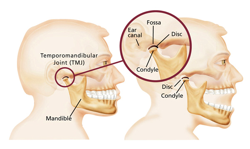Temporomandibular Joint (TMJ)

The temporomandibular joints are the two joints that connect your jaw to your skull. These joint slide and rotate in front of each ear. The TMJ joint consists of the mandible (lower jaw) and the temporal bone (the side and base of the skull). This joint allows the mandible to move up and down, side to side, and forward and back.
Temporomandibular Joint Dysfunction
When the joints are properly aligned, smooth actions such as chewing, talking, yawning, and swallowing can take place. When these structures (muscles, ligaments, and the jaw bone) aren't functioning well, several problems may occur. Temporomandibular joint dysfunction is any problem that prevents the system of muscles, bones, and joints from working properly.
- Jaw discomfort or soreness
- Headaches
- Pain radiating behind the eyes
- Earaches or ringing in the ears
- Clicking or popping of the jaw
- Locking of the jaw
- Limited mouth motions
- Clenching or grinding of the teeth
- Dizziness
- A change in the way the upper and lower teeth fit together (occlusion)
Physical therapy helps ease pain, regain natural jaw movement, and lessen daily stress on the jaw. Your therapist will select treatments that will work best for you. Your treatments may include: posture education, improving jaw movement with various mobilization techniques, electrical stimulation, or ultrasound. Your therapist will keep your dentist or referring specialist updated with your plan of care and progress.